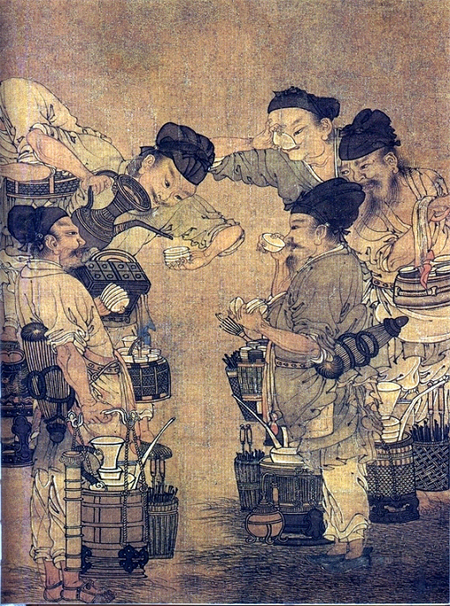Local tea houses boost influence of tea culture

Liu Songnian's painting Competition in the Tea Market depicts tea vendors in a competition for the highest quality tea in the Southern Song Dynasty.
The Tang Dynasty set the stage for modern Chinese tea culture. This was when Lu Yu, known as “the Sage of Tea” wrote the The Classic of Tea, and also when Chinese tea crossed the sea and arrived in Japan, which laid the foundations for the evolution and development of Japanese tea ceremonies.
The saying “Tea rose in the Tang Dynasty but flourished in the Song Dynasty” may be connected with the popularity of tea competitions in the Song Dynasty. Tea competitions, or dou cha, refer to competitions in which teas were compared and ranked by tea growers and consumers.
Chinese tea culture extends beyond the tea itself and also refers to connected aspects, such as behavior and culture. Chinese tea culture combines drinking tea with a philosophy of life. The saying “Tea is life” comes from a Chinese understanding of life, reflecting the color of Zen and the spiritual origins of tea ceremonies. Because Chinese tea culture integrates the ideas of Confucianism, Buddhism and Taoism; tea manners, virtues, ceremonies and art have come into being, and these are at the core of Chinese tea culture. Local tea houses all over the country are the most typical examples of tea culture in China’s urban areas.
1. Beijing teahouses
In Beijing, many teahouses combine tea drinking with the art of storytelling. The stories utilize a traditional style of oral speaking performance that has been popular since the Song Dynasty. Drinking tea is just a medium, but listening to local artists’ storytelling is often the main reason to go to a teahouse in Beijing. Various folk art forms, such as Jingyun Dagu, the storytelling in Beijing dialect with drum accompaniment, are also popular among tea consumers.
2. Hangzhou teahouses
While Hangzhou does not have as many teahouses as Chengdu, Hangzhou teahouses have a stronger cultural atmosphere—a style of elegance and Zen and Buddhist colors—inherited from the Southern Song Dynasty. Hangzhou teahouses usually use pure spring water to make West Lake Longjing tea.
3. Guangzhou teahouses
Guangzhou teahouses look more like beautiful restaurants, and they often serve breakfast. A pot of tea, some dim sum and open discussions with relatives and friends are the essence of life for Guangzhou locals. They call this practice “eating morning tea.”
